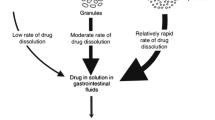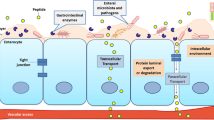Abstract
Currently available antiulcer drugs suffered from serious side effects which limited their uses and prompted the need for a safe and efficient new antiulcer agent. The objective of this project work was to retain the drug in the stomach for better antiulcer activity and less side effects. Hence, the aim of our present work was to prepare a gastric floating tablet of Berberine hydrochloride (Ber) with suitable in vitro/vivo properties. In this study, different Ber gastric floating tablets were prepared by simple direct compression using various amounts of HPMCK15M and Carbopol 971PNF combined with other tablet excipients. The properties of the tablets including hardness, buoyancy, swelling ability, in vitro drug release, and in vivo pharmacokinetic study were evaluated. The obtained results disclosed that hardness, floating, swelling, and in vitro drug release of the Ber tablets depended mainly on the ratio of polymer combinations. Moreover, among six formulations, F3 exhibited desirable floating, swelling, and extended drug release. In addition, in vivo pharmacokinetic study suggested that prepared gastric floating tablets had significantly sustained-releasing effects compared with market tablets. Therefore, the developed gastric floating tablets of Ber could be an alternative dosage form for treatment of gastrointestinal disease.




Similar content being viewed by others
References
Goodman KJ, Cockburn M. The role of epidemiology in understanding the health effects of Helicobacter pylori. Epidemiology. 2001;12:66–271.
Tarnawski AS, Ahluwalia A. Molecular mechanisms of epithelial regeneration and neovascularization during healing of gastric and esophageal ulcers. Curr Med Chem. 2012;19(1):16–27.
Najm WI. Peptic ulcer disease. Prim Care. 2011;38(3):383–94. vii.
Beil W, Kilian P. EPs 7630, an extract from Pelargonium sidoides roots inhibits adherence of Helicobacter pylori to gastric epithelial cells. Phytomedicine. 2001;14:5–8.
Liang S, Kuang Y, Ma F, et al. A sensitive spectrofluorometric method for detection of berberine hydrochloride using Ag nanoclusters directed by natural fish sperm DNA. Biosens Bioelectron. 2016;85:758–63.
Simeon S, Rios JL, Villar A. Pharmacological activities of protoberberine alkaloids. Plant Med Phytother. 1989;23:02–250.
Liu Y, Yu H, Zhang C, et al. Protective effects of berberine on radiation-induced lung injury via intercellular adhesion molecular-1 and transforming growth factor-beta-1 in patients with lung cancer. Eur J Cancer. 2008;44(16):2425–32.
Weber HA, Zart MK, Hodges AE, et al. Chemical comparison of goldenseal (Hydrastis canadensis L.) root powder from three commercial suppliers. J Agric Food Chem. 2003;51(25):7352–8.
Domadia PN, Bhunia A, et al. Berberine targets assembly of Escherichia coli cell division protein FtsZ+. Biochemistry. 2008;47(10):3225–34.
Hsieh YS, Kuo WH, et al. Protective effects of berberine against low-density lipoprotein (LDL) oxidation and oxidized LDL-induced cytotoxicity on endothelial cells. J Agric Food Chem. 2007;55(25):10437–45.
Zhang X, Yang Y, Gang S, et al. Su1190 berberine-, allicin-or clarithromycin-based triple therapy for the first-line treatment of Helicobacter pylori infection: an open-label, randomized trial. Gastroenterology. 2014;146:S398.
Zhang S-L, Li H, He X, et al. Alkaloids from Mahonia bealei posses anti-H+/ K+ -ATPase and anti-gastrin effects on pyloric ligation-induced gastric ulcer in rats. Phytomedicine. 2014;21:1356–63.
Baird AW, Taylor CT, Brayden DJ. Non-antibiotic anti-diarrhoeal drugs: factors affecting oral bioavailability of berberine and loperamide in intestinal tissue. Adv Drug Deliv Rev. 1997;23:111–20.
Lee YS, Kim WS, Kim KH, et al. Berberine, a natural plant product, activates AMP-activated protein kinase with beneficial metabolic effects in diabetic and insulin-resistant states. Diabetes. 2006;55:2256–64.
Yin L, Qin C, Chen K, et al. Gastro-floating tablets of cephalexin: preparation and in vitro/ in vivo evaluation. Int J Pharm. 2013;452:241–8.
Yusif RM, Abu Hashim II, Mohamed EA, et al. Gastroretentive matrix tablets of Boswellia oleogum resin: preparation, optimization, in vitro evaluation and cytoprotective effect on indomethacin-induced gastric ulcer in rabbits. AAPS PharmSciTech. 2016;17:328–38.
Kriangkrai W, Puttipipatkhachorn S, Sriamornsak P, et al. Impact of anti-tacking agents on properties of gas-entrapped membrane and effervescent floating tablets. AAPS PharmSciTech. 2014;15:1357–69.
Streubel A, Siepmann J, Bodmeier R. Gastroretensive drug delivery systems. Expert Opin Drug Deliv. 2006;3:217–33.
Strusi OL, Sonvico F, Bettini R, et al. Module assemblage technology for floating systems: in vitro flotation and in vivo gastro-retention. J Control Release. 2008;129:88–92.
Hirtz J. The GIT absorption of drugs in man: a review of current concepts and methods of investigation. Br J Clin Pharmacol. 1985;19:77S–83S.
Fell JT. Targeting of drugs and delivery systems to specific sites in the gastrointestinal tract. J Anat. 1996;189:517–9.
Murphy CS, Pillay V, Choonara YE, Du Toit LC. Gastroretentive drug delivery systems: current developments in novel system design and evaluation. Curr Drug Deliv. 2009;6:451–60.
Nayak AK, Maji R, Das B. Gastroretentive drug delivery systems: a review. Asian J Pharm Clin Res. 2010;3:2–10.
Bravo-Osuna I, Vauthier C, Farabollini A, et al. Mucoadhesion mechanism of chitosan and thiolated chitosan-poly (isobutyl cyanoacrylate) core-shell nanoparticles. Biomaterials. 2007;28:2233–43.
El-Zahaby SA, Kassem AA, El-Kamel AH. Formulation and in vitro evaluation of size expanding gastro-retentive systems of levofloxacin hemihydrates. Int J Pharm. 2014;464:10–8.
Sugihara H, Matsui Y, et al. Development of a gastric retentive system as a sustained release formulation of pranlukast hydrate and its subsequent in vivo verification in human studies. Eur J Pharm Sci. 2014;53:62–8.
Tuleu C, Andrieux C, Boy P, Chaumeil JC. Gastrointestinal transit of pellets in rats: effect of size and density. Int J Pharm. 1999;180:123–31.
Stops F, Fell JT, Collett JH, Martini LG. Floating dosage forms to prolong gastro-retention—the characterisation of calcium alginate beads. Int J Pharm. 2008;350:301–11.
Bardonnet PL, Faivre V, Pugh WJ, et al. Gastroretensive dosage forms: overview and special case of Helicobacter pylori. J Control Release. 2006;111:1–18.
Sermkaew N, Wiwattanawongsa K, Ketjinda W. Development, characterization and permeability assessment based on caco-2 monolayers of self-microemulsifying floating tablets of tetrahydrocurcumin. AAPS PharmSciTech. 2013;14:321–31.
Yuhe S, Xin H, Xiaolin Y, et al. Absorption characteristics of the total alkaloids from Mahonia bealei in an in situ single-pass intestinal perfusion assay. Chin J Nat Med. 2014;12:0554–60.
Rosa M, Zia H, Rhodes T. Dosing and testing in vitro of a bioadhesive and floating drug delivery system for oral application. Int J Pharm. 1994;105:65–70.
Dorozynski P, Jachowicz R, Kulinowski P, et al. The polymers for the preparation of hydrodynamically balanced systems—methods of evaluation. Drug Dev Ind Pharm. 2004;30:947–57.
Patel A, Modasiya M, Shah D, Patel V. Development and in vivo floating behavior of verapamil HCl intragastric floating tablets. AAPS PharmSciTech. 2009;10:310–5.
Chinese Pharmacopoeia Commission. Pharmacopoeia of the People’s Republic of China. Part 1. Beijing: China Medical Science Press; 2010. p. 79.
Dredan J, Istvan R, Istvan A, et al. Evaluation of mathematical model describing drug release from lipophilic matrices. Int J Pharm. 1996;145:61–4.
Higuchi T. Mechanism of sustained-action medication. Theoretical analysis of rate of release of solid drugs dispersed in solid matrices. J Pharm Sci. 1963;52:1145–9.
Ritger PL, Peppas NA. A simple equation for description of solute release I. Fickian and non-fickian release from non-swellable devices in the form of slabs, spheres, cylinders of discs. J Control Release. 1987;5:23–36.
Wai-Yip Lee T, Robinson RJ. Controlled drug delivery systems. In: Gennaro AR, editors. Remington: The science and practice of pharmacy. 2000. p. 903–929.
Korsmeyer RW, Gurny R, Doelker E, Buri P, Peppas NA. Mechanisms of solute release from porous hydrophilic polymers. Int J Pharm. 1983;15:25–35.
Narasimhan B. Mathematical models describing polymer dissolution: consequences for drug delivery. Adv Drug Deliv Rev. 2001;48:195–210.
Takahara J, Takayama K, Nagai T. Multiobjective simultaneous optimization technique based on an artificial neural network in sustained release formulations. J Control Release. 1997;49:11–20.
Qi X, Chen H, Rui Y, et al. Floating tablets for controlled release of ofloxacin via compression coating of hydroxypropyl cellulose combined with effervescent agent. Int J Pharm. 2015;489:210–7.
Ranade AN, Wankhede SS, Ranpise NS, et al. Development of bilayer floating tablet of amoxicillin and Aloe vera gel powder for treatment of gastric ulcers. AAPS PharmSciTech. 2012;13:1518–23.
Nama M, Gonugunta CSR, Veerareddy PR. Formulation and evaluation of gastroretentive dosage forms of clarithromycin. AAPS PharmSciTech. 2008;9(1):231–7.
Tadros MI. Controlled-release effervescent floating matrix tablets of ciprofloxacin hydrochloride: decvelopment, optimization and in vitro-in vivo evaluation in healthy human volunteers. Eur J Pharm Sci. 2010;74:332–9.
Viridén A, Wittgren B, Larsson A. Investigation of critical polymer properties for polymer release and swelling of HPMC matrix tablets. Eur J Pharm Sci. 2009;36:297–309.
Hu L, Li L, Yang X, et al. Floating matrix dosage form for dextromethorphan hydrobromide based on gas forming technique: in vitro and in vivo evaluation in healthy volunteers. Eur J Pharm Sci. 2011;42:99–105.
Acknowledgments
This research was supported in part by a grant (BK 20131309) from The Natural Science Foundation of Jiangsu Province (CHN) and a grant (81573565) from The Natural Science Foundation of China (NSFC).
Author information
Authors and Affiliations
Corresponding authors
Ethics declarations
All the animal experiments were approved and supervised conducted by the China Pharmaceutical University Ethics Committee of Care and Use of laboratory animals. All the animals were house and handled according to the University Unit for Laboratory Animal Medicine guidelines.
Conflict of Interest
The authors declare that they have no conflicts of interest.
Additional information
Jun Ji and Xin He contributed equally to this work.
Rights and permissions
About this article
Cite this article
Ji, J., He, X., Yang, XL. et al. The In vitro/vivo Evaluation of Prepared Gastric Floating Tablets of Berberine Hydrochloride. AAPS PharmSciTech 18, 2149–2156 (2017). https://doi.org/10.1208/s12249-016-0696-7
Received:
Accepted:
Published:
Issue Date:
DOI: https://doi.org/10.1208/s12249-016-0696-7




